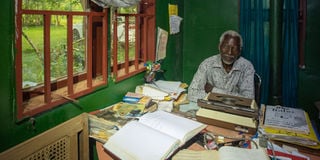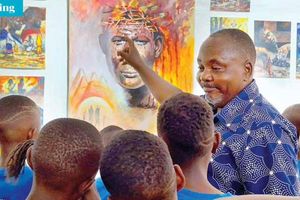
Kaddu Wasswa in his office in Mayirikiti, Buikwe. He has documented Uganda through different sectors such as art, theatre and politics. PHOTO/Andrea Stultiens
There was a time when the National Theatre did not operate as a national institution. It was called a national theatre, but African plays, in this case local productions, could not find a home at the venue.
Constructed by the British for their own entertainment; most of the plays that were staged at the venue were often William Shakespeare’s, and a number of others were from Indians and Goan Indians.
In fact, most of the teams that went out to represent Uganda in competitions, were usually made up of Indians and the British.
When Wycliffe Kiyingi’s Pio Mberenge Kamulali was staged at the National Theatre in the 1950s, it was the first play by an African to achieve such a feat.
Yet, even before he brought his play to the theatre, there were other local producers, who had joined hands to see Ugandan plays showcased.
And Kaddu Wasswa was one of them.
Kaddu, in 1954, wrote to Maxwell Jackson, the then director at the National Theatre, asking for an opportunity to have African productions in the theatre. In a reply letter he documented, Maxwell welcomed the idea, but turned down his request because the production was not done by him.
That rejection letter is not the only thing that Kaddu has documented. He has kept a number of letters and done many writings, some of which are commentaries on what was happening in Uganda at the time.
For example, his thoughts on being turned down by the National Theatre are expressed in a written message in Luganda, discussing the significance of Uganda being appreciated by its own people. He says he does not write to seek glory, but to educate a future generation.
“I want my grandchildren to know that in our home there was leadership that worked towards liberating the black person from control arising from ignorance,” says one of the texts.
In January, Kaddu’s works and writings were exhibited at The Capsule Gallery, an independent art space founded in 2023 by the Afropocene StudioLab in Kampala. The gallery focuses on innovative and immersive exhibition styles.
Located at Yujo Izakaya, Kyadondo Road, the gallery is a small experimental space that offers minimalist exhibition experiences in close-up. Kaddu Wasswa’s exhibition, Afropocene: The Capsule and History in Progress, collaborated to present a bite-size exhibition of the Kaddu Wasswa Archive in celebration of his 90th birthday.
History in Progress, also known as HIPUganda is an initiative by artist Canon Griffin and Dutch photographer Andrea Stulteins, who collect and publish photographs from private collections about Uganda. Over the years, they have published private collections of Elly Rwakoma, Martin W Wambwa, Muteesa I’s picture, whose genesis has been debatable.
Alongside the publications, they have also held various exhibitions, in fact, this is not the first exhibition they are part of in regards to Kaddu Wasswa’s collection.
Kaddu has been on a mission not only to serve his community as a social worker, environmentalist, and grassroots philosopher, but also to be able to tell his own story. At 90, he is still a keen observer of life, community, and country.
The work on display included, but was not limited to, art, culture, theatre, politics, the environment and writings. These are in the form of photography, artefacts, and writings.
Some of the writings are his, but others are by other people; some are firsts, such as Independence Day publications and advertisements of the time; then the artefacts include a typewriter, some newspapers and a picture of him in his shop in 1971, among others.
Kaddu stays in Mayirikitti Village in Buikwe District. He has stayed in the same house since the 1960s, and it is there that he puts together ideas.
Over the years, he has since collaborated with Andrea Stultiens, a Dutch researcher and photographer, who is interested in Ugandan history and ways of making it accessible.
Since their first meeting in 2008, they have authored two books together. The first of these, The Kaddu Wasswa Archive: A Visual Biography, offers quirky but interesting insights into self-education, of a man who had a difficult childhood.
Born in 1933, Kaddu was christened John, however, in the Waganda Review, it is said that he has a complicated relationship with the name, thus, it may not be of surprise that he does not use it often.
Growing up, it appears he had a strange relationship with religion. For instance, in one of his writings, he talks about being introduced to the Bible and later hating the book because it was mainly referred to as a Holy book.
“What I knew was that all so-called ‘Holy Books’ were embodying literature for those who were anointed. I could not open a Bible if I found it on my bed. I could pick it up very carefully and put it somewhere and wonder how the Bible could find itself on my bed,” he says.




